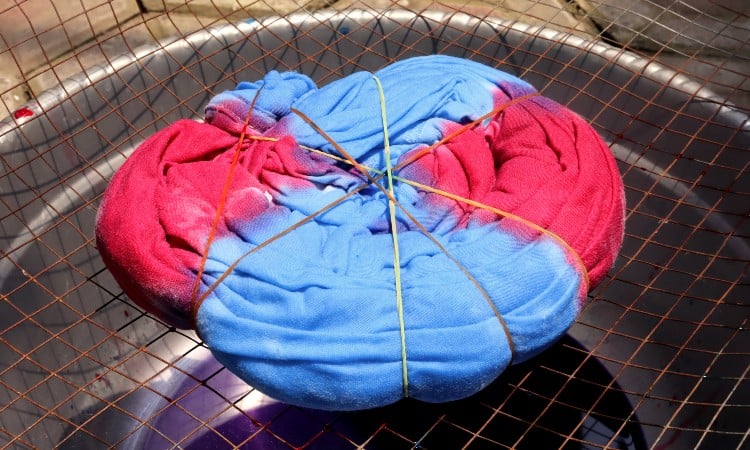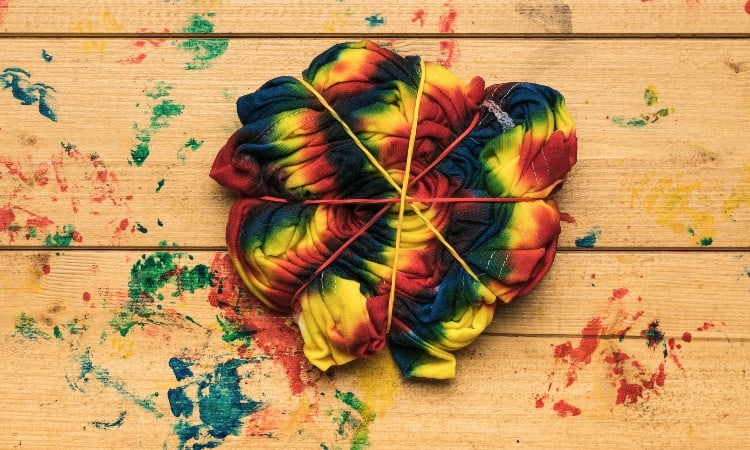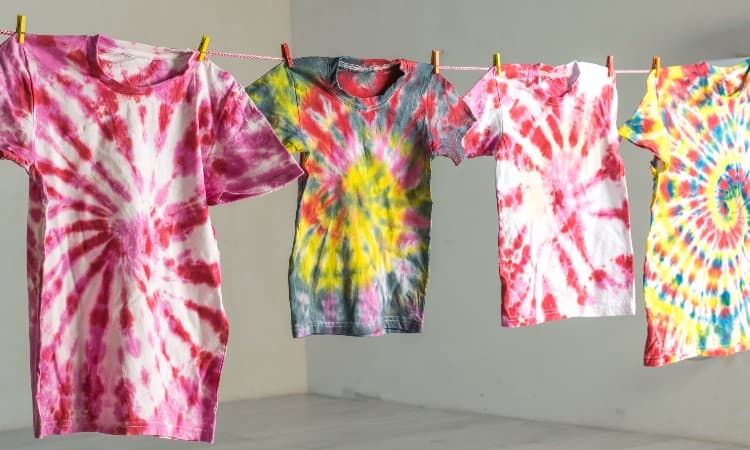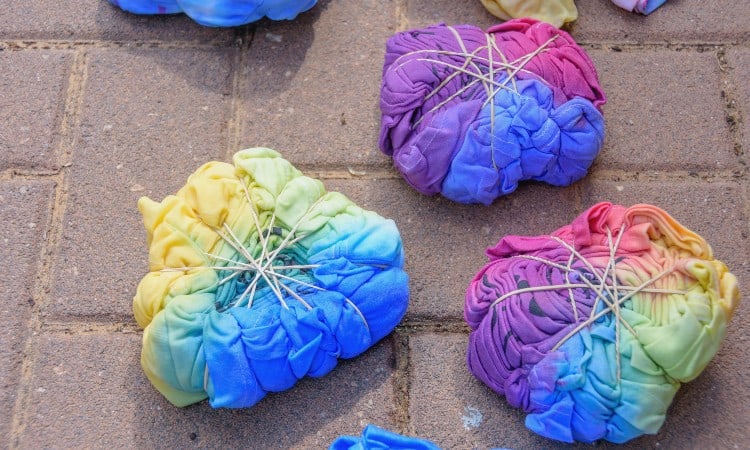If you spent hours creating an elaborate rainbow swirl in a tie-dye t-shirt, the last thing you want is to see the color fade away or come out in the wash! You can avoid this by allowing the fresh dye to sit for a while and finish the chemical reaction process you started when you put the dye on the fabric. But how long do you need to let the dye sit before washing the shirt?
The best way to avoid color bleeding in tie-dye is to allow it to sit for 8 to 24 hours before rinsing it out. This depends on the type of dye used, as all-purpose dyes require a shorter resting period, and fiber-reactive dyes need a longer resting period. Keeping the fabric sealed in a bag or container will prevent the color from drying out and fading during this process.
In this article, you will learn what happens to dye when it sits in wet fabric. You will find out how long to let different kinds of tie-dye projects sit before washing. Finally, you will find tips on how to safely rinse and wash your new tie-dye after this sitting period.

Quick Navigation
Does Tie-Dye Need to Rest After Dyeing?
Most kinds of tie-dye require a long resting period after dyeing to allow the dye to react with the fibers in the fabric. During this resting time, you should ensure the item or garment remains damp and in its original tied, twisted, or scrunched shape. If you remove the rubber bands or ties, the pattern you so carefully created may blur or bleed.
No matter what kind of coloring agent you used or what fabric you tie-dyed, some of the color will adhere right away during the dyeing process. But for a rich, permanent kind of colorfastness, most dyes need a resting period. This means that if you rinse the garment or item right away, a lot of the color will simply wash away with the water as it never had time to bond with the fibers in the fabric.
You can use heat to bypass this waiting period in some cases. You may find “helpful” tips online recommending that you rinse your tie-dye in vinegar or salt water instead of using a resting period. This does not work!
For some types of dyes, vinegar, salt, or soda ash can work as a color fixative during the dyeing process. But these will not allow you to skip the resting period after the dyeing process. If you rinse a freshly tie-dyed shirt in vinegar, most of the color will leak away!
All this goes to say that the resting period does matter. But you will find that many factors such as the type of dye and the temperature inside your house can also impact exactly how long you need to let the tie-dye sit.
How Long to Let Tie Dye Sit Before Washing?

The basic rule of thumb is to let a tie-dyed item sit for at least 8 and no more than 24 hours before rinsing it and then washing it. Eight to twenty-four hours is a pretty wide range, though, so these next sections can help you narrow down the time window depending on what kind of dye, fabric, and fixative you used.
Type of Dye
One of the biggest factors determining how long you need to allow a newly dyed item to rest is what kind of dye you used. The good news here is that whatever kind of dye you bought, you will find directions for resting and washing on the package! Tie-dye kits should also come with clear directions about how long to rest a freshly dyed item.
You can find general guidelines for resting periods based on the type of dye here, but keep in mind that you should always follow the specific instructions on your packaging for the best results.
Fiber Reactive Dyes
 Tie-dye that uses fiber-reactive dyes requires a resting period of 4 to 24 hours.
Tie-dye that uses fiber-reactive dyes requires a resting period of 4 to 24 hours.
Typically, you will use either fiber reactive, all-purpose, or disperse dyes for a tie-dye project.
These days, most tie-dye kits contain fiber-reactive dyes such as the Tulip brand, Dharma, and Jacquard brand.
Fiber reactive dyes bond with cellulose molecules inside certain types of fabric, using a strong covalent bond between the color particles and the fabric fibers. This creates a permanent, colorfast, vibrant fabric.
This type of dye works best on fabric that contains cellulose, meaning plant-based materials like cotton and linen. Many artists also use it on silk by adding a few additional steps to the process.
The key thing to know about fiber reactive dye resting periods is that they need to rest for four hours. After this, the color will grow brighter with time. You can allow an item to rest for up to 24 hours for the maximum color saturation or stop closer to the four-hour mark if you want a pale, more pastel shade.
All-Purpose Dyes
 Tie-dye that uses all-purpose dyes does not require any resting period, though this kind of dye will not deliver very permanent or vibrant colors.
Tie-dye that uses all-purpose dyes does not require any resting period, though this kind of dye will not deliver very permanent or vibrant colors.
Before the recent development of fiber reactive dyes, most home dyeing projects used all-purpose dyes that easily dissolve into a water bath. Brands like RIT continue to sell quite popular all-purpose dyes often used for tie-dye projects.
This type of dye generally contains a blend of various other types of dyes, like direct and acid dyes. As the name suggests, all-purpose dyes can work on almost all types of fabrics. The only exception is synthetics–any material containing more than 40% of a synthetic fabric like polyester will not hold all-purpose dye.
All-purpose dye has a generic appeal because of this and also offers easy application. But it does not provide the level of colorfastness and color saturation that many other coloring agents can offer.
When dyeing an item using all-purpose dye, you need to let it sit in the dyebath for ten to thirty minutes. However, after that, you do not let the item rest at all! You either rinse it in a color fixative solution or simply wash it in your kitchen sink right away after the dyeing finishes.
Disperse Dyes
 Tie-dye made with disperse dyes can either rest for 4 to 24 hours or go into a special wash with synthrapol after the dyeing process.
Tie-dye made with disperse dyes can either rest for 4 to 24 hours or go into a special wash with synthrapol after the dyeing process.
Many brands sell accessible at-home disperse dyes. RIT has a line of disperse dyes called RIT DyeMore, for example. Make sure you read the product description to determine that a dye packet actually contains disperse dyes and says that it will work on polyester.
Disperse dye is the only kind of coloring agent that works well on synthetic materials like polyester. Heat and chemical reactions allow the tiny color particles to bond with the plastic fibers inside polyester during the dyeing process.
Because you have to use a boiling water bath to activate this process, you can only create one-color tie-dye using this method (or at least, you can only apply one color at a time!). This makes tie-dyeing polyester quite difficult, but you can do it if you master the intricacies of disperse dyes.
Some brands of disperse dye recommend using a resting period for the damp, freshly dyed item. Others like RIT DyeMore skip this step and inside, take the item right out of the boiling dye bath and put it into a boiling rinse and wash process immediately after finishing the dyeing.
The most important element for fixing the color when using disperse tie-dye is the temperature. You need a building dye bath that simmers for at least 30 minutes.
Acid Dyes
 Acid dyes do not typically require a resting period, but they need a lengthier dyeing session.
Acid dyes do not typically require a resting period, but they need a lengthier dyeing session.
Acid dyes are not the best choice for tie-dyeing because they require a hot dye bath, just like disperse dyes. Despite that, this is the best kind of dye to use on fabric made out of protein fibers such as wool and silk. Acid dyes do not contain any type of acid, but you add vinegar to the hot dye bath, which activates the color particles and causes them to bind to the proteins.
Jacquard and Dharma both sell acid dyes for at-home use. These will come with instructions indicating how much vinegar to add during the boiling dye bath.
In most cases, you will not let an item sit after this at all. Instead, you will immediately put it into a hot water and soap wash.
Type of Fixative
Another factor that can impact the resting period for your tie-dye is whether or not you use a dye fixative.
What is a dye fixative? Most commercial fixatives work on direct, all-purpose, and acid dyes by creating a positive charge that causes the dye particles to swell up inside the fabric. This kind of fixative is called “cationic” because of its positive charge.
Popular brands of fixatives for at-home use include RIT ColorStay, Retayne, and Dharma Dye Fixative. Each product should come with directions telling you how to apply it and how long to let a dyed item rest after using the fixative.
You do not need to use a color fixative on fiber-reactive or disperse dye projects. This product works well on all-purpose dyes and does slow down the inevitable washout of color when you use a product like an all-purpose RIT dye.
You may find that using a dye fixative bath, as RIT recommends, will cause your tie-dye colors to bleed together. So you kind of run into a Catch-22 there–either let the colors fade or let them bleed together as you fix them in place! One way around this is to find a color fixative that comes in spray form.
Either way, using a dye fixative does cut down on the time you need to let the dye rest. For most products, you may only need to let the freshly dyed item sit for 20 minutes after soaking in or spraying on a fixative! Of course, you should always go by the recommended resting period on dye-fixative packaging.
Type of Fabric
The type of fabric you use impacts the dye resting period because it determines what kind of dyes you can use.
- Plant-based fabrics such as cotton will work with all-purpose or fiber-reactive dyes. Depending on what type of fixative you use, both of these kinds of dyes usually require at least an 8-hour resting period.
- Polyester, nylon, and other synthetics need disperse dyes applied in a boiling bath. The dye bath has to last at least 30 minutes, but in most cases, you do not have to have a resting period before rinsing and washing the garment.
- Animal-based fabrics like silk and wool require acid dyes. You add vinegar during the dyeing process for most brands of acid dye, but you do not need to let the product rest afterward. Instead, you put it straight into a hot wash.
Temperature
Temperature plays a crucial role in determining how long you need to let tie-dye sit before washing.
First, some kinds of dye require high temperatures to bond the color to the fabric. Disperse and acid dyes, for example, both need simmering dye baths.
Second, heat can often speed up the resting period for all-purpose or fiber-reactive dyes. A lack of heat can also make this process take longer. If you wrap up your tie-dyed item and leave it outdoors overnight, the nighttime temperatures could chill the fabric and slow down the setting process.
The good news is that dye kits or individual dye packets will always tell you the ideal temperature for the dye bath and the dye setting period if one is required! A general rule of thumb to remember is that most dyes will set best at temperatures of 70℉ or above.
Can You Let Tie Dye Sit Too Long?

You can let tie-dye sit too long if you leave it for more than the recommended setting period indicated on the dye package. For most types of dye, you can leave a sealed-up tie-dye item to sit for up to 24 hours. The longer it sits, the darker the color will get.
But if you leave the damp tie-dye fabric sitting any longer than that, you will start to see discoloration in the fabric. This can happen if the dye darkens on its own because it sat so long or because some of the fabric fibers began to dry out, causing uneven dyeing.
On top of this, leaving a wet fabric item sitting for too long will create an environment rife with mold and mildew! This can happen if you leave tie-dye to sit for too long without rinsing and washing the garment or item.
So, leaving tie-dye to sit for up to 24 hours is usually safe, but you should never let it sit for two days or more!
Can You Make the Dye Set Faster?
You can make tie-dye colors set faster by applying higher temperatures. If you used a type of dye that required a resting or sitting stage, you can often shorten the length of time by putting the tie-dyed item in a hotter environment.
For example, most fiber-reactive dyes recommend a resting temperature of at least 70℉. If you up that by ten degrees and place the tie-dyed item in a room with a temperature of 80℉, it will set much more quickly, in as little as four hours!
If you really want to work quickly, you can also try microwaving a tie-dyed item.
- Start by placing your freshly dyed item inside a Ziploc bag and sealing it shut.
- Put the bag in the microwave and turn on the microwave for one minute.
- Next, run two more one-minute bursts in the microwave, pausing a few seconds between each.
- Let the shirt cool for ten minutes before opening the bag.
- Finally, rinse out the shirt to remove excess dye.
How to Rinse Tie-Dye
You follow the same basic steps to rinse out and wash your tie-dye no matter what kind of dye or fabric you used!
The only variation is whether you should use hot or cold water. Here is an easy way to remember that: if you used a hot dye bath, you should rinse your tie-dye in hot water. If you let your tie-dye sit wrapped in plastic, you can use cool water for rinsing and washing.
To rinse tie-dye:
- Wear rubber gloves and old clothing, so you do not splash dye onto yourself. If you used a hot dye bath, use tongs to transfer the very hot garment to your rinsing station.
- Cut through and remove any rubber bands or string you used to hold the pattern in place while dyeing.
- Once you have the item in your sink, turn on the water and rinse until you no longer see dye running away down the drain.
- This process takes a while! Make sure you get all the crumpled or folded bits and rinse in the sleeves and along the neckline.
To wash your tie-dye for the first time:
- Use cold water if you used cold water for rinsing or hot water if you used hot water for rinsing. Sometimes a type of dye may require a special laundry detergent for the first wash–for example, disperse dyes may need a detergent called synthrapol. But usually, you can use a gentle, generic detergent in your machine.
- Put the tie-dyed item in by itself for the first wash.
- If you tie-dyed fabric that can go in the dryer, try adding a tennis ball to fluff up the garment and help it dry all the way. If you dyed wool, silk, or more delicate fabric, allow it to air dry.
Should Tie-Dye Dry Before Washing?
You should never let tie-dye dry before washing. If you let a freshly dyed item dry out, some parts will dry faster than others, and the still-damp sections will dye a darker color!
This is why most tie-dye methods call for wrapping the item in plastic wrap or sealing it inside a zip baggy as it sets.
If you use a kind of dye that does not need a resting period, you typically go straight to the rinsing and washing stage after dyeing.
Once you have completed the full dyeing, setting, rinsing, and washing process, you can finally safely allow the item to dry!
Can You Leave Tie-Dye in the Sun?

You can leave tie-dye in the sun if you wrap it up in air-tight plastic packaging or a plastic bag first. The sun will increase the temperature and humidity inside the bag, causing the dye to set faster in many cases!
Remember that outdoor temperatures can change dramatically over a 24-hour period, though. This means that you may want to bring the tie-dyed item inside before the sun goes down. Otherwise, the colder overnight temperatures could slow down the setting process.
Also, some kidneys of dye recommend a more specific temperature for the setting period. In that case, you may want to either use a thermometer to keep an eye on the outdoor temperature or just keep the time inside.
Conclusion
Most kinds of tie-dye need to sit for 8 to 24 hours before rinsing out the dye and washing the garment or item. Some kinds of dye can sit for as little as four hours to as much as 24, and a few types of dye, like disperse dyes, do not require any resting period at all! Most of the time, a longer sitting period leads to darker, bolder colors in the finished tie-dye product.
The factors that determine how long you need to let your tie-dye sit include the kind of dye you used, the kind of fabric you used, and whether or not you applied a dye fixative. The temperature around the tie-dye as it rests can also make a big difference. If you need to rush the resting period, you can microwave your tie-dye to make it set in a hurry!